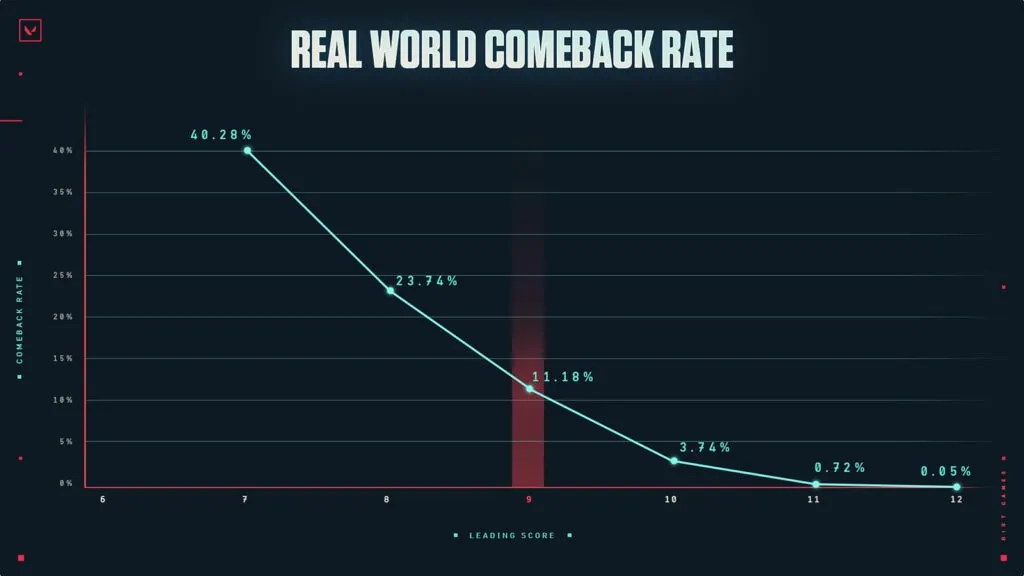The 9-3 curse has officially become the stuff of Valorant lore.
The superstitious believe that finishing the first half with a 9-3 scoreline portends a comeback for the enemy team — citing plenty of examples in pro play to back it up.
In one of the most infamous performances, 100 Thieves turned the tide against Gambit Esports in Masters Berlin, coming back from a 9-3 deficit to win on Icebox.
But is the curse actually real? Riot Games looked at the numbers to answer that question.
- Best Sage wall spots on Fracture: Tips and tricks for defenders
- Valorant Neon guide: 3 best Relay Bolt lineups on Icebox
How often does the 9-3 curse happen?

Looking at data from over 25 million competitive matches, Riot found a clear negative correlation between the comeback rate and the number of rounds a team trailed at the half. The higher the deficit, the lower the comeback rate.
Riot defines a comeback as either a 13-round win or a forced overtime by the team that was losing initially, regardless of whether that team won or lost in OT.
A team trailing 5-7 at the half mounts a comeback roughly 40 percent of the time, while a team that is down 0-12 only pulls off a reverse sweep a measly 0.05 percent of the time.
More importantly, teams that were lagging behind 3-9 only had an 11.18 percent chance to tie or win by the end of the game, according to Riot.
That doesn’t seem like a particularly good chance to win the game. So where does the curse come from? As it turns out, there was something funky in the numbers when Riot dug deeper.
The team projected the comeback rate for each map, looking at factors like whether players were attacking or defending and the rounds won at half-time. They compared these numbers to the actual win rate, so they could find out how much better or worse teams were performing compared to the mathematical odds against them.

Oddly enough, there was a noticeable spike at the 8-4 and 9-3 scores. Teams trailing 4-8 beat the projected odds 4.75 percent of the time, while teams trailing 3-9 defied the projections 4.41 percent of the time. That’s more than twice the jump in odds at 7-5 or 10-2.
But what’s really going on? The answer may lie more in Valorant’s economy than any sort of superstitious shenanigans. The first few rounds in the second half play a big role in a team’s odds of coming back. The odds of a comeback increase or decrease dramatically depending on how a team performs in the pistol, eco, and bonus rounds.
For instance, trailing teams who win the first three rounds then go on to win their game 36.33 percent of the time. Suddenly, the score is 6-9, and the losing team also has a very big economic advantage.
These scenarios happen fairly often, and can quickly obliterate what at first appears to be a commanding lead — and that may be where the origin of the curse lies.
“Players are overestimating the safety that a 9-3 lead provides,” said Riot researcher Ash “Riot Kona” Garrett.
“According to our projections, a 9-3 lead shouldn’t actually be too uncommon between evenly matched teams. We might have cases of leading teams seeing a skill diff that actually isn’t there and getting a little too comfortable, while trailing teams are taking advantage of both an economic and mental reset — with a little help from the myth of the curse.”
No, the 9-3 curse isn’t real — you are not more likely to comeback from a 3-9 score than you are a 5-7 deficit. But a comeback remains very possible, if only you win the first few rounds.
You can read Riot’s full blog post here.
READ MORE: Every VCT NA Challengers league team to watch in 2023

